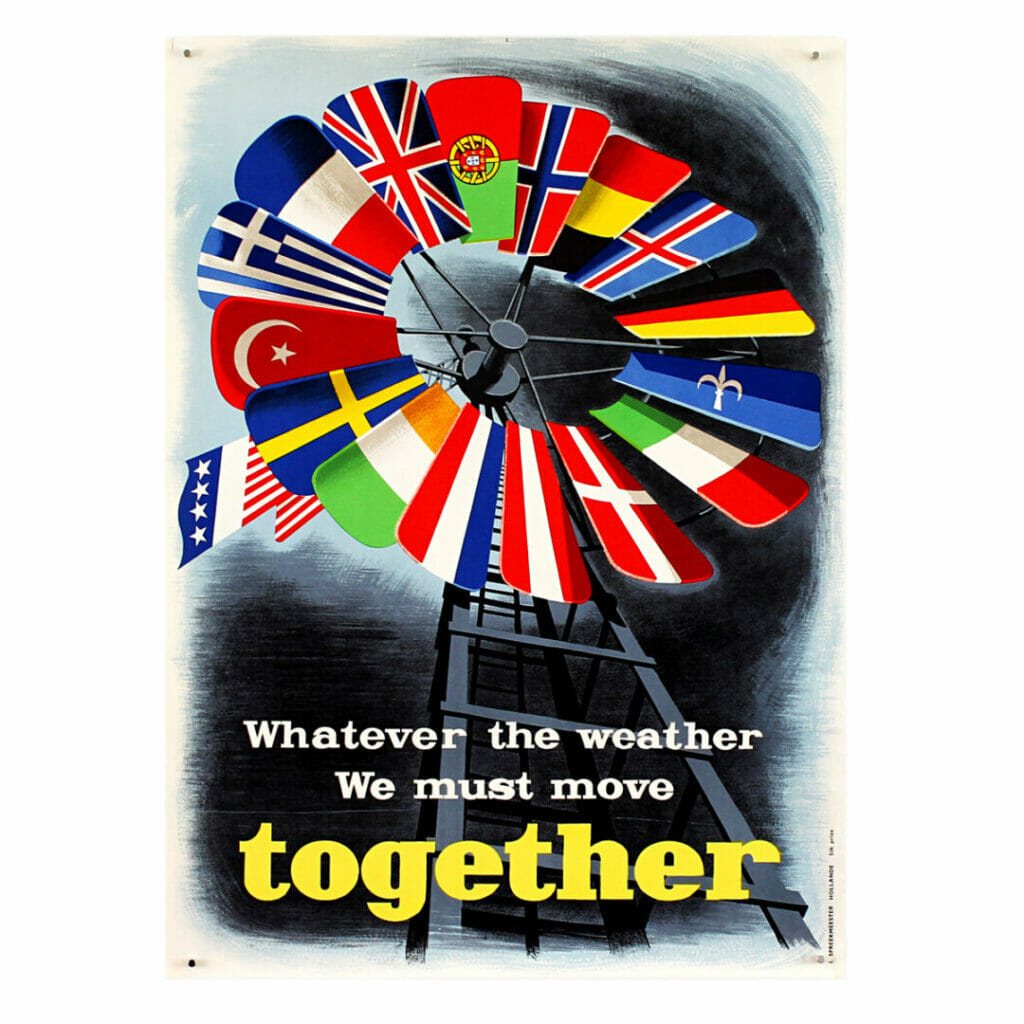Because of the growing famine and dearth that is being wrought in because of environmental disasters and supply chains collapsing, one foodtech investor and founder is urging the world to join together to completely reshape the global food systems.
Johan Jorgensen, founder of Sweden Foodtech, is calling for another “Marshall Plan” to deal with these problems.
The National Archives explains what the Marshall Plan was:
On April 3, 1948, President Truman signed the Economic Recovery Act of 1948. It became known as the Marshall Plan, named for Secretary of State George Marshall, who in 1947 proposed that the United States provide economic assistance to restore the economic infrastructure of postwar Europe.
When World War II ended in 1945, Europe lay in ruins: its cities were shattered; its economies were devastated; its people faced famine. In the two years after the war, the Soviet Union’s control of Eastern Europe and the vulnerability of Western European countries to Soviet expansionism heightened the sense of crisis.
To meet this emergency, Secretary of State George Marshall proposed in a speech at Harvard University on June 5, 1947, that European nations create a plan for their economic reconstruction and that the United States provide economic assistance.
On December 19, 1947, President Harry Truman sent Congress a message that followed Marshall’s ideas to provide economic aid to Europe. Congress overwhelmingly passed the Economic Cooperation Act of 1948, and on April 3, 1948, President Truman signed the act that became known as the Marshall Plan.
Over the next four years, Congress appropriated $13.3 billion for European recovery. This aid provided much needed capital and materials that enabled Europeans to rebuild the continent’s economy.
For the United States, the Marshall Plan provided markets for American goods, created reliable trading partners, and supported the development of stable democratic governments in Western Europe. Congress’s approval of the Marshall Plan signaled an extension of the bipartisanship of World War II into the postwar years.
(George Marshall’s full transcript can be read there as well)

Jorgensen, whose company specializes in optimizing technology and artificial intelligence to produce food, believes this type of plan needs to be revisited but with a modern application.
The following is Jorgensen opinions, per AgFunder News:
The horrific events in Ukraine continue to fill global hearts, minds, and, to a far lesser degree, bellies. Perhaps this is the wake-up call we need for a Marshall Plan for food.
Food exports once more flow from Ukraine. However, this year’s supply chain breakdowns for food and fertilizers have lingering implications. Hopefully, those implications will make us think about food in new ways, and to finally move on from today’s production paradigm.
Russia’s war of aggression reminds me of a study from the Aalto University in Finland about a year ago. The study noted that by the end of the century, up to one-third of global food crop and livestock production could be pushed outside what is called “the safe climatic space.” These areas contain workable amounts of the essential climate factors for agriculture: rain, aridity, and temperatures.
If we behave really, really well and keep temperature increases to 1.5 or 2 degrees Celsius, we might limit the effects of climate change to 5-8% of food production. But that is nothing I would bet the house on.
Earlier this year, BlackRock CEO Larry Fink said in a letter to shareholders that the globalization movement is essentially dead. Given that, which parts of food production will be outside the safe political space?
That will be the subject of many frantically-written strategy reports in the future. We face an uncertain food future with huge fluctuations due to climate change, new political realities, and maybe more wars. The only consolation is that the Ukraine crisis has fast-forwarded what nature was already going to throw at the global food system over the next few decades.
Consequences of a global grain diet
One of the reasons for this dire situation is that we have put ourselves on a global grain diet.
According to World Bank, the production of cereals grew fourfold over the last 60 years; the population “only” grew by 150%. We simply started eating more grains thanks to the Green Revolution. This meant more safe and cheap calories (in the short run), but also more power to the grain-producing nations of the world.
The main grain-producing and exporting countries in the world are, as usual, the developed ones. Over the last 60 years, these countries have been able to throw policy, capital and technology onto food in the form of the Green Revolution. This has resulted in a massive increase of the production of grains such as wheat.
This arrangement will likely accelerate. According to a study by NASA, the production of wheat could potentially see a growth of about 17% by as early as 2030, while maize was projected to decline by 24%. One intuitively understands which crop is produced where.
Developed countries now export many of the staples the world consumes. In return, they import specialty crops such as coffee, tea, exotic fruits, vegetables, and spices. This can be seen as a matter of normal economic specialization emanating from global trade. Or it could be seen as good ol’ colonialism in a new cloak. In any case, our current food system is not only about food but also about political power.
Food could become an even more important geopolitical tool as Russia’s vast food-producing capabilities need to find new customers that do not hate the country intensely. What to do with your oversupply of wheat and other staples? Why, you convert food into fealty of course!
A new Green Revolution
But it does not have to be that way. In Europe, we are currently weaning ourselves off of Russian carbon fuels at a pace unthinkable only a few months ago. A combination of political will, massive investments, and technology can shift mountains in a short time.
Can we achieve similar results for food? Absolutely. We can start by talking about energy.
This picture from NASA’s Earth Observations shows net primary productivity (NPP) across the planet. NPP is simply the rate at which energy (sunlight) gets stored as biomass through photosynthesis. The greener it gets, the higher the productivity.
It is at its highest in the tropics.
While tropical latitudes are not as suitable for the large-scale production of grains such as wheat, it is possible to grow a lot of other crops. And it is long past time to focus our energy and resources towards building a new green revolution based on NPP: the tech, the models, the methods, the science, the political insights, and the will. This ambition is nothing new, but perhaps current geopolitical developments can help speed things up.
Through farming concepts such as permaculture and its hyper-productive cousin Synecoculture, paired with the NPP of the tropics, there actually is a potential to reverse the global food flows. In fact, it seems that a measly 10 square meters of the right land in the tropics farmed through the Synecoculture method can support one human being.
If we used 1% of the tropics for farming in this way, we could support close to 50 billion people on planet Earth. We could also upend the geopolitical side effects of the Green Revolution.
Leveraging NPP
The tropics are of course vastly diverse, and I would be loath to be called out as another middle-aged white guy wanting to save the poor people in the South. But the underutilization of the NPP probably represents the largest arbitrage in the history of man. It is such a waste in so many dimensions at the same time it makes your head spin.
And unless the Western world wants to see Russian influence grow through grains it might be wise to start thinking in the dimensions of a Marshall Plan for food.
For now, Larry Fink is right. Today and in the nearest future, the greatest geopolitical potential in food lies in producing the staples we have grown accustomed to. But perhaps the geopolitical calculation can tip the scales and unleash the enormous amount of resources and innovation needed to rapidly redraw the rules of the food game, for the sake of peace and prosperity.
Which, by the way, should have been done a long time ago.
AUTHOR COMMENTARY
He that is surety for a stranger shall smart for it: and he that hateth suretiship is sure.
Proverbs 11:15
Obviously this is more gaslighting and blowing hot carbon dioxide out of the mouth of a greenie who wants to make a LOT of money at your expense. Of course, this follows the typical nonsense that all the world’s problems are “Pootin’s” problems.
In reality what this is, is him telling us what the plan will be coming down the pike when the Western economies finally are allowed to fully collapse and implode. When the people are in deep penury, ruination, starvation, and so on; then these elitist psychopaths will offer their solution, to which the desperate masses will accept without question.
These new partnerships will result in nothing good, needless to say, proliferate all of the expressed goals of the United Nations, World Economic Forum, and Vatican.
[1] My son, if thou be surety for thy friend, if thou hast stricken thy hand with a stranger, [2] Thou art snared with the words of thy mouth, thou art taken with the words of thy mouth. [3] Do this now, my son, and deliver thyself, when thou art come into the hand of thy friend; go, humble thyself, and make sure thy friend. [4] Give not sleep to thine eyes, nor slumber to thine eyelids. [5] Deliver thyself as a roe from the hand of the hunter, and as a bird from the hand of the fowler. Proverbs 6:1-5
[7] Who goeth a warfare any time at his own charges? who planteth a vineyard, and eateth not of the fruit thereof? or who feedeth a flock, and eateth not of the milk of the flock? [8] Say I these things as a man? or saith not the law the same also? [9] For it is written in the law of Moses, Thou shalt not muzzle the mouth of the ox that treadeth out the corn. Doth God take care for oxen? [10] Or saith he it altogether for our sakes? For our sakes, no doubt, this is written: that he that ploweth should plow in hope; and that he that thresheth in hope should be partaker of his hope. (1 Corinthians 9:7-10).
The WinePress needs your support! If God has laid it on your heart to want to contribute, please prayerfully consider donating to this ministry. If you cannot gift a monetary donation, then please donate your fervent prayers to keep this ministry going! Thank you and may God bless you.








It was all such a deception, the Marshall Plan. Selling out all of East Europe & most of Asia for their bloody idolatrous pagan humanist dream: building the system of antichrist & covert MYSTERY. Better off are all those who died for being true for Christ behind the Iron and Bamboo ‘Curtains’, than those ‘survivors’ who compromised to sacrificing them ….and so many babies, innocent, weak & little ones, spreading their vile corruption & doctrines of death & devils everywhere….but those who observe lying vanities forsake their own mercy. If we’re going to be ‘vomited’….let it be out of her…Revelation 18 and the sign of Jonah…
–
Jon 2:7 When my soul fainted within me I remembered the LORD: and my prayer came in unto thee, into thine holy temple.
Jon 2:8 They that observe lying vanities forsake their own mercy.
Jon 2:9 But I will sacrifice unto thee with the voice of thanksgiving; I will pay that that I have vowed. Salvation is of the LORD.
Jon 2:10 ¶ And the LORD spake unto the fish, and it vomited out Jonah upon the dry land.
For the most part, this is all by design. Planned out and set into motion by the arrogant satanists behind the curtains. The first time was to gain power and money, now they want to get rid of 85% – 90% of us!